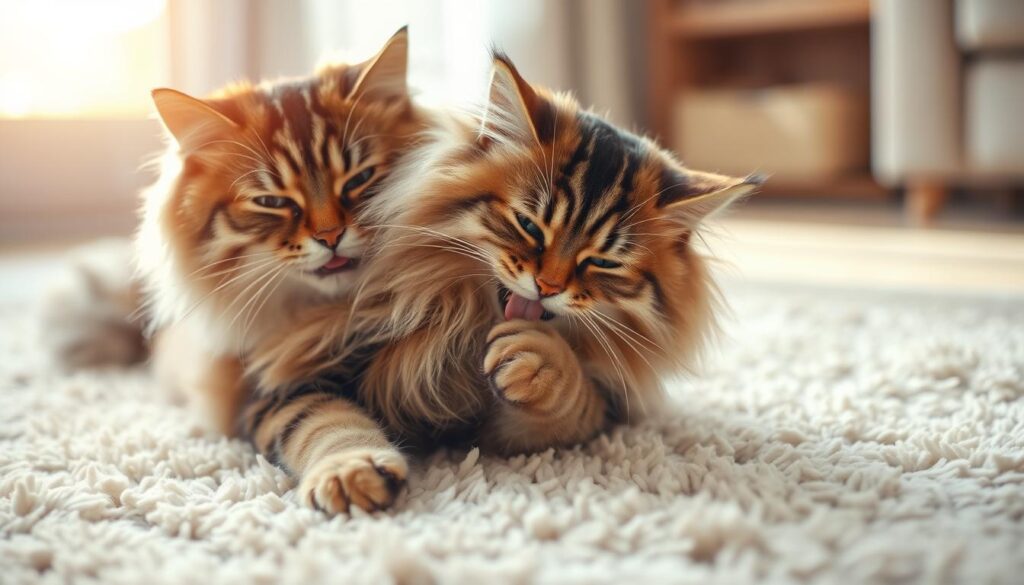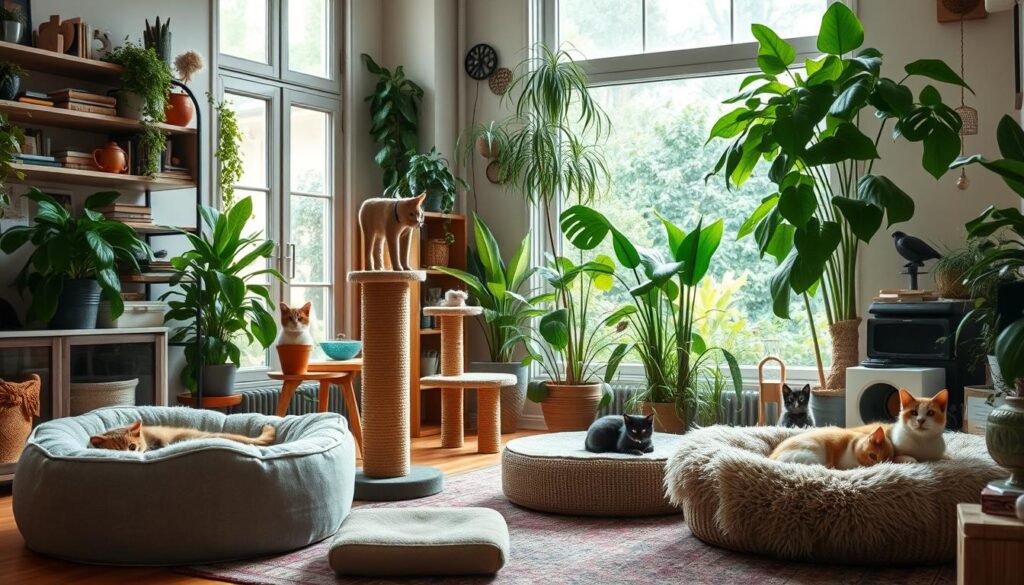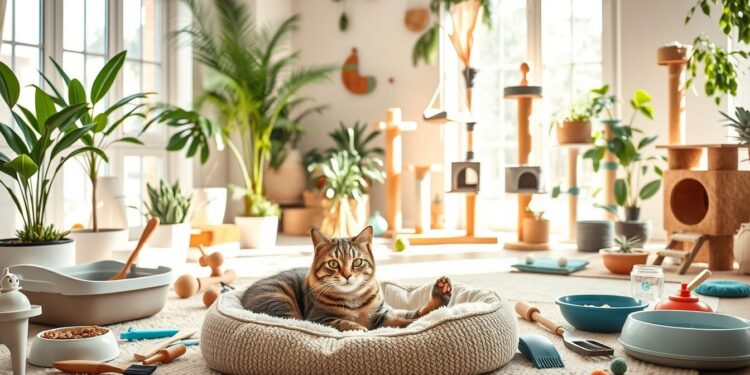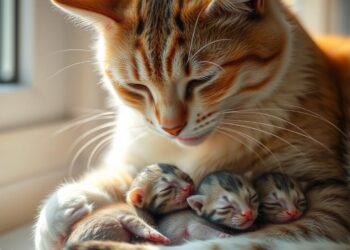Welcoming a new feline friend into your home can be a thrilling experience. As a new owner, you want to ensure your pet feels comfortable and secure in their new environment.
Creating a welcoming and healthy environment is crucial for your pet’s overall well-being. This involves providing the right nutrition, maintaining a grooming routine, and designing a cat-friendly home.
By following these essential cat care tips, you can help your pet thrive. As a responsible owner, it’s natural to feel overwhelmed, but with the right guidance, you can give your pet the best possible start in life.
Getting Started with Your New Feline Companion
Bringing home a new cat can be both exciting and intimidating, but with the right knowledge, you can ensure a happy and healthy start. As a new cat owner, it’s essential to understand the basics of cat behavior and how to create a welcoming environment for your pet.
Understanding Cat Behavior Basics
Cats are known for their independence, but they also have a nurturing side. Understanding that your cat will be a little shy at first is crucial. It’s perfectly normal for them to feel nervous and hide. Providing a quiet and comfortable space can help your cat feel more at ease. Observing your cat’s behavior and body language is key to understanding their needs and emotions.
The First Week Adjustment Period
The first week is critical for your cat’s adjustment to the new home. Keep the environment calm and minimize changes to help your cat settle in. It’s also a good time to establish a routine for feeding, play, and sleep. This consistency will provide your cat with a sense of security and stability.
Creating a Safe Introduction to Your Home
When introducing your cat to your home, it’s crucial to do it gradually. Start with one room, making sure it’s safe and cat-proofed. Remove hazardous items, secure loose wires, and ensure that toxic substances are out of reach. Creating a safe space for your cat to retreat to when feeling overwhelmed is also important.
By understanding cat behavior basics, being patient during the first week adjustment, and creating a safe introduction to your home, you can set the stage for a happy and healthy life with your new feline companion.
Essential Cat Care Tips for Proper Nutrition
Ensuring your cat receives the right nutrients is crucial for their longevity and quality of life. Proper nutrition is fundamental to maintaining your cat’s overall health, influencing aspects such as energy levels, coat condition, and disease prevention. Best practices for cat care emphasize the importance of a well-balanced diet tailored to your cat’s specific needs.
Selecting Age-Appropriate Cat Food
Cats have different nutritional requirements at various stages of their lives. Kittens, adults, and seniors need age-appropriate cat food to meet their specific developmental or maintenance needs. For instance, kittens require more protein and calories to support their rapid growth.
Establishing a Healthy Feeding Schedule
A healthy feeding schedule is vital to prevent overeating and maintain optimal weight. The frequency of feeding depends on the cat’s age, size, and activity level. Generally, cats thrive on two meals a day, but some may require more frequent, smaller meals.
Wet vs. Dry Food: Finding the Right Balance
The debate between wet vs. dry food centers on the benefits of each type. Wet food provides higher moisture content, which can be beneficial for urinary health, while dry food helps maintain dental health. A balanced approach that includes both can offer the advantages of each.
Monitoring Weight and Adjusting Diet
Monitoring weight is crucial to prevent obesity or malnutrition. Regular weigh-ins and body condition scoring can help determine if dietary adjustments are needed. AvoDerm’s range of wet and dry food for cats offers varied flavors and nutritional profiles to suit different life stages and preferences.
| Life Stage | Nutritional Needs | Recommended Food Type |
|---|---|---|
| Kitten | High protein, high calories | AvoDerm Wet Food |
| Adult | Balanced nutrients | AvoDerm Dry Food |
| Senior | Easier to digest, lower calories | AvoDerm Senior Formula |
Mastering Litter Box Setup and Maintenance
The litter box is a critical component of your cat’s daily life, requiring careful setup and maintenance. A well-designed litter box setup is essential for your cat’s hygiene and health.
Choosing the Right Litter Box Type and Size
Selecting the appropriate litter box type and size is crucial. Consider your cat’s size, age, and preferences when choosing between covered or uncovered, and large or small litter boxes. Generally, a larger litter box is recommended as it provides your cat with enough space to turn around comfortably.
Strategic Placement and Number of Boxes
It’s typically a good idea to have one litter box per cat, plus an extra box. Cats can be territorial about their litter boxes, so ensuring enough space is vital. Place litter boxes in quiet, accessible locations, avoiding areas near their food and water.
Litter Selection and Cleaning Routine
Choosing the right litter and maintaining a regular cleaning routine are vital. Cats prefer a clean environment, so daily scooping and regular litter changes are necessary. Consider your cat’s preferences and allergies when selecting litter.
Addressing Common Litter Box Problems
Common issues include accidents outside the litter box, litter box avoidance, and litter box soiling. Addressing these issues promptly involves checking the litter box cleanliness, size, and location, and making adjustments as necessary.
Grooming Essentials for a Healthy Cat
Grooming is a vital aspect of cat care that contributes significantly to your cat’s overall health and well-being. Regular grooming not only keeps your cat’s coat clean and healthy but also helps in reducing shedding and preventing hairballs. Moreover, grooming sessions provide an excellent opportunity to bond with your cat and check for any signs of health issues.

Brushing Techniques for Short and Long-Haired Cats
Brushing your cat regularly is essential, regardless of their coat length. For short-haired cats, a rubber brush or a soft-bristle brush works well, while long-haired cats benefit from a pin brush or a slicker brush to prevent matting. Regular brushing helps distribute skin oils, reducing shedding and preventing hairballs.
Bathing Guidelines: When and How
Most cats are meticulous about their cleanliness and rarely need a bath. However, when they do, it’s crucial to follow proper bathing guidelines. Use a mild cat-specific shampoo, and ensure the water is not too hot or cold. Gently massage the shampoo into their coat, and rinse thoroughly to prevent skin irritation.
Safe Nail Trimming Procedures
Nail trimming is a critical aspect of cat grooming. To trim your cat’s nails safely, use a cat-specific nail clipper, and avoid cutting the quick (the pink part of the nail). It’s advisable to trim just the tip to prevent pain and bleeding.
Establishing a Dental Care Routine
Dental care is often overlooked but is crucial for your cat’s overall health. Brushing your cat’s teeth regularly with a cat-specific toothbrush and toothpaste can help prevent tartar buildup and gum disease. Start slowly and be patient, as it may take time for your cat to get accustomed to the process.
| Grooming Task | Frequency | Tips |
|---|---|---|
| Brushing | Daily/Weekly | Use appropriate brushes for coat type |
| Bathing | Rarely needed | Use mild shampoo, avoid extreme temperatures |
| Nail Trimming | Every 4-6 weeks | Avoid cutting the quick |
| Dental Care | Daily | Use cat-specific toothbrush and toothpaste |
Preventative Healthcare and Veterinary Care
Ensuring your cat’s health requires a proactive approach to preventative healthcare and regular veterinary care. This not only enhances their quality of life but also helps in early detection of potential health issues.
Essential Vaccination Schedule
Vaccinations are a critical component of preventative healthcare. Your veterinarian will recommend a vaccination schedule based on your cat’s age, lifestyle, and health status. Core vaccines protect against diseases such as rabies, feline distemper, and feline calicivirus.
Flea, Tick, and Worm Prevention
Fleas, ticks, and worms can cause significant discomfort and health problems for your cat. Using preventative measures such as topical treatments, collars, and medications can help protect your cat from these parasites. Regular checks and maintaining a clean environment are also crucial.
Benefits of Spaying and Neutering
Spaying or neutering your cat can prevent unwanted breeding, reduce the risk of certain health issues like uterine infections and testicular cancer, and curb undesirable behaviors such as spraying or roaming. It’s a responsible decision that contributes to your cat’s health and well-being.
Recognizing Signs That Require Veterinary Attention
Being able to identify signs of illness or injury in your cat is vital. Look out for changes in appetite, vomiting, diarrhea, lethargy, or difficulty breathing, and seek veterinary care promptly if you notice any of these symptoms. Early intervention can make a significant difference in treatment outcomes.
By following these preventative healthcare measures and staying vigilant about your cat’s health, you can help ensure they lead a long, healthy, and happy life.
Creating a Cat-Friendly Home Environment
To ensure your cat’s happiness and health, it’s essential to transform your home into a cat-friendly space. This involves several key steps to make your home safe and enjoyable for your feline companion.
Cat-Proofing Your Living Spaces
Cat-proofing is crucial to prevent accidents and injuries. Secure loose wires, toxic substances, and fragile items out of your cat’s reach. Use cord protectors and secure heavy objects to prevent them from tipping over.

Household Toxins and Plants to Avoid
Some household items and plants are toxic to cats. Keep toxic substances like cleaning supplies and medications out of reach. Avoid having toxic plants like lilies, sago palms, and tulips in your home.
Setting Up Comfortable Resting Areas
Cats need comfortable and quiet places to rest. Provide soft bedding and quiet spaces for your cat to relax. Consider setting up cat beds or blankets in cozy areas.
Providing Vertical Space and Window Access
Cats love to climb and observe their surroundings from above. Install cat shelves or cat trees to provide vertical space. Ensure windows are secure and consider using window perches for safe viewing.
Play and Exercise Strategies for Physical and Mental Health
Engaging your cat in regular play and exercise is crucial for maintaining their physical and mental well-being. This not only helps in burning energy but also in stimulating their natural hunting instincts.
Selecting Appropriate Toys
Choosing the right toys for your cat depends on their age, breed, and individual preferences. Interactive toys like feather wands and laser pointers are excellent for encouraging active play.
Structuring Interactive Play Sessions
To keep playtime engaging, vary the types of toys and activities. For example, start with a feather toy, then switch to a laser pointer. This variety helps keep your cat interested and stimulated.
Exercise Requirements by Age and Breed
Different cats have different exercise needs based on their age and breed. For instance, younger cats and breeds like Bengals require more vigorous exercise compared to older cats or less energetic breeds.
| Age/Breed | Exercise Needs | Recommended Activities |
|---|---|---|
| Kitten (0-1 year) | High Energy | Feather toys, laser pointers |
| Adult Cat | Moderate | Interactive toys, climbing structures |
| Senior Cat | Low | Gentle play with soft toys |
Enrichment Activities
To prevent boredom, incorporate enrichment activities such as puzzle toys filled with treats. These challenge your cat mentally and provide a sense of accomplishment.
Socialization and Bonding with Your Cat
The journey to a strong and healthy relationship with your cat begins with effective socialization and bonding techniques. Socialization is crucial for your cat’s emotional and psychological development, helping them become confident and calm in the presence of people and other pets.
Building Trust Through Positive Interactions
Positive interactions are the foundation of trust between you and your cat. Spend quality time with your cat, engaging in activities they enjoy, such as playing with feather toys or simply cuddling. Consistency and patience are key to building this trust.
Safe Introduction to Other Household Pets
Introducing your new cat to other household pets requires careful planning. Start by keeping them separated and allowing them to become familiar with each other’s scents and sounds before a face-to-face meeting. Monitor their behavior closely during these initial interactions.
Teaching Children Proper Cat Handling
It’s essential to teach children how to handle cats gently and respectfully. Demonstrate how to support the cat’s body and avoid picking them up by their ears or tail. Supervise interactions between children and cats to ensure safety for both.
Reading and Respecting Feline Body Language
Understanding feline body language is vital for a harmonious relationship. Recognize signs of stress or fear, such as flattened ears or a twitching tail, and give your cat space when needed. Paying attention to these cues can prevent misunderstandings and strengthen your bond.
| Socialization Tip | Description | Benefit |
|---|---|---|
| Positive Interactions | Engage in activities your cat enjoys | Builds trust and strengthens bond |
| Gradual Introductions | Introduce pets slowly and under supervision | Reduces stress and promotes harmony |
| Respectful Handling | Teach children to handle cats gently | Ensures safety and comfort for both |
Must-Have Supplies for New Cat Owners
As a new cat owner, setting up your home with the right supplies is crucial for your cat’s health and happiness. Having the essential items not only makes your life easier but also ensures your cat adjusts well to its new environment.
Essential Equipment Checklist
To get started, you’ll need a few essential cat supplies. These include:
- A comfortable cat bed or bedding
- A litter box and litter
- A scratching post to save your furniture
- Food and water bowls
- A cat carrier for safe travel
- Toys for stimulation and play
These items are fundamental in creating a welcoming space for your cat.
Quality vs. Cost: Where to Invest
When it comes to cat supplies, the decision between quality and cost can be challenging. While it might be tempting to opt for cheaper options, investing in high-quality, durable products can be more cost-effective in the long run. For instance, a sturdy scratching post or a well-made cat bed may cost more initially but will last longer, providing better value.
Budgeting for Ongoing Cat Care Expenses
Owning a cat comes with ongoing expenses, including food, litter, and veterinary care. Budgeting for these costs is essential to ensure you can provide for your cat’s needs without financial strain. Consider setting aside a monthly amount for cat care expenses to make caring for your pet more manageable.
Space-Saving Solutions for Apartment Living
For those living in apartments, space can be a concern. Fortunately, there are many space-saving cat supplies available, such as collapsible litter boxes, wall-mounted scratching posts, and compact cat beds. These solutions can help you provide a comfortable and engaging environment for your cat, even in smaller living spaces.
By focusing on these must-have supplies and considering factors like quality, cost, and space, you can create a happy and healthy home for your new cat.
Basic Training and Behavior Management
Basic training and behavior management are key to a harmonious relationship with your feline companion. Effective training not only helps in housebreaking but also strengthens the bond between you and your cat.
Positive Reinforcement Training Methods
Positive reinforcement is a powerful training tool. By rewarding desired behaviors with treats, praise, or play, you can encourage your cat to repeat those actions. For example, when your cat uses the litter box correctly, reward them with a treat.
Addressing Scratching, Biting, and Other Unwanted Behaviors
Unwanted behaviors like scratching furniture or biting can be challenging. Redirecting these behaviors to appropriate alternatives, such as scratching posts, can help. Consistency and patience are key.
Litter Training and Reinforcement
Litter training is essential for a clean and healthy home. Place your cat in the litter box after meals or playtime to create a positive association. Praise and reward successful uses.
When to Consult a Feline Behaviorist
If you’re struggling with persistent behavioral issues, consider consulting a feline behaviorist. These experts can provide personalized guidance and help you address complex problems.
| Training Method | Description | Effectiveness |
|---|---|---|
| Positive Reinforcement | Rewarding desired behaviors | High |
| Redirecting Behavior | Redirecting unwanted behaviors | Medium |
| Litter Training | Training for litter box use | High |
Conclusion: Building a Lifelong Bond with Your Cat
Welcoming a new cat into your life can be a truly rewarding experience. By following the top cat care tips outlined in this article, you can create a happy and healthy environment for your feline friend.
As a new cat owner, it’s essential to remember that building a lifelong bond with your cat requires attention to their physical and emotional needs. Providing a nurturing environment, complete with proper nutrition, regular grooming, and plenty of playtime, will help strengthen your relationship.
By implementing these feline care suggestions, you’ll be well on your way to creating a strong and lasting bond with your cat. Whether you’re looking for top tips for cat owners or simply want to ensure you’re providing the best possible care, following these cat care tips will help you build a lifelong connection with your furry companion.







